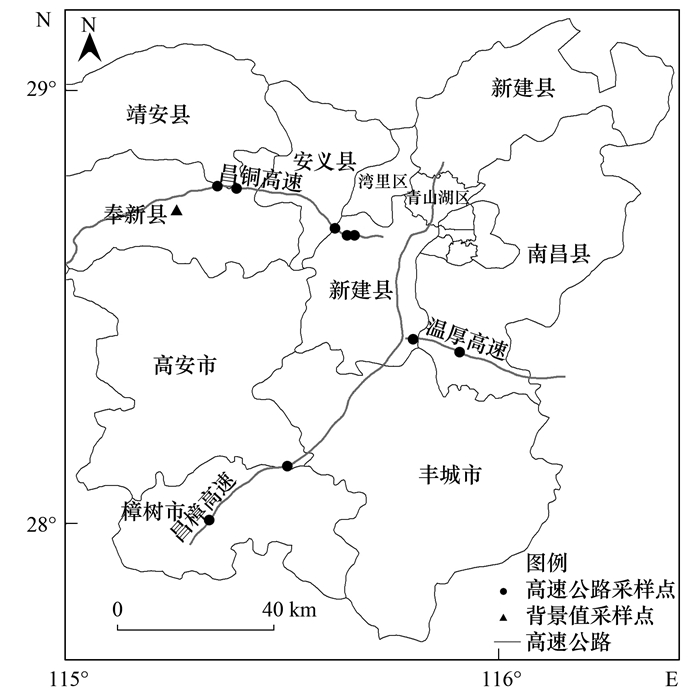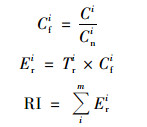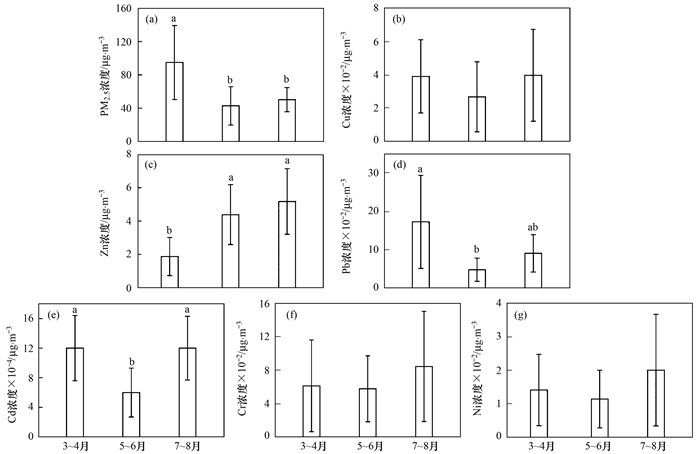自2013年全国大范围连续高强度的大气污染事件后, 细颗粒物PM2.5的污染已被高度关注, PM2.5的研究也成为大气环境的研究热点之一. PM2.5指悬浮在空气中, 动力学当量直径不大于2.5 μm的颗粒物, 由于其可直接通过呼吸道进入肺部, 故也称为可吸入颗粒物.有研究表明颗粒物的粒径越小其重金属元素的含量越高[1], PM2.5吸附的有毒重金属(Cd、Cr、Cu、Ni、Pb和Zn)很可能对人体健康造成潜在危害[2, 3], 如Cu会引起记忆力减退, 可能导致肝功能异常;Zn浓度过高引发动脉硬化;Cd可引起肾损伤;Cr和Ni易诱发人体细胞组织的癌变;Pb能够伤害人体, 严重影响儿童的智力发育[4].
近几年国内对于PM2.5重金属污染的研究多集中在城市或者郊区等大区域范围[3, 5~12], 主要的研究方向包括健康风险评价[5, 9~11], 污染特征研究[7, 8]及源解析方面[6, 12], 城市PM2.5中重金属主要污染源包括燃煤、工业、交通等.而以交通为主要来源PM2.5研究报道较少, 其中Hou等[13]和王成辉等[14]对高速公路隧道的大气颗粒物进行研究, 分析了隧道内大气颗粒物的污染特征, 近期Li等[15]探讨了高速公路收费站工作人员的重金属健康风险评价, 赵兴敏等[16]分析了长春市高架桥公路的PM2.5重金属元素污染特征, 但其包括了除交通源外其他人为源的干扰.截止2017年4月, 江西省机动车保有量已达651万辆, 其中汽车保有量突破425万辆, 以615.3%的增长速度成为全国私家车数量增长最快的省份.近年来江西省高速公路建设迅猛发展, 2016年底高速通车里程数已达到6000 km.随着江西省及周边省份城市的快速发展, 以及高速公路客运量和货运量的攀升, 诸多人群长期往返于高速公路, 而目前国内对高速公路收费站、服务区PM2.5及其重金属相关研究鲜见报道.因此, 基于前人的研究, 本文通过监测昌樟、昌铜和温厚这3条高速不同沿线的PM2.5及其中重金属(Cu、Zn、Pb、Cd、Cr和Ni)浓度, 分析高速公路沿线PM2.5中重金属的污染水平及污染特征, 以期为防治高速公路及大气PM2.5中重金属污染提供科学依据.
1 材料与方法 1.1 采样地点本研究选择南北走向的昌樟高速, 以及东西走向的昌铜和温厚高速, 这3条高速公路在建设时期、车流量和地形地势等方面均有较大差异, 可代表目前江西省高速公路的整体情况, 有利于展开高速公路PM2.5中重金属污染特征的研究.
3条高速公路中服务区、收费站和隧道作为主要采样点, 昌樟高速选择胡家坊收费站和樟树服务区, 温厚高速选择丰厚收费站和南昌南服务区, 昌铜高速选择奉新收费站和奉新服务区, 昌铜高速昌奉段中拥有梅岭和萧峰两条隧道, 其中梅岭隧道长3430 m(属于特长隧道), 萧峰隧道长1197 m(属于长隧道), 因此本研究在两条隧道中心处采集PM2.5样品, 同时在两条隧道的公路沿线亦设置了采样点, 保证了3个采样点不受车流量的影响.另外, 选择距昌铜高速1 km以外的无工厂的张坊村竹林作为PM2.5的背景值.具体的采样点如图 1所示.

|
图 1 高速公路PM2.5采样点 Fig. 1 PM2.5 sampling sites on highway |
采用智能中流量空气总悬浮微粒采样器(青岛崂山, TH-150C)对高速公路沿线PM2.5样品进行采集, 使用的滤膜为聚丙烯滤膜, 采样高度距地面1.5 m.采样前后将聚丙烯膜放置恒温恒湿箱中恒重, 用精度为0.01 mg的天平称重, 并用铝箔纸封装保存于-20℃冰箱待分析.采样时间从2018年3~8月, 每2个月集中采样1次, 服务区、收费站(有电源)连续24 h采样, 公路沿线、隧道内(无电源)连续6h采样, 梅岭隧道、萧峰隧道及2条隧道公路沿线中PM2.5样品的采集保证同时进行.采样期间, 用自动气象监测仪(QT1010, 美国)测定气温、湿度、风向、风速等气象参数.采样期间的气象参数如表 1所示.
|
|
表 1 采样期间的气象参数 Table 1 Partial metrological parameters during the sampling periods |
1.3 样品的分析测定
PM2.5质量浓度测定按《环境空气PM10和PM2.5的测定重量法》(HJ 618-2011)进行. PM2.5中重金属浓度的样品处理按照《空气和废气颗粒物中铅等金属元素的测定电感耦合等离子体质谱法(ICP-MS)》(HJ 657-2013)中的方法, 采用ICP-MS(NexIon-350x, 美国)分析PM2.5中的Cu、Zn、Pb、Cd、Cr和Ni的质量浓度, 相应金属元素检出限分别为:0.0007、0.003、0.0006、0.00003、0.001和0.0005 μg·m-3.
1.4 数据分析本研究主要采用地累积指数法、富集因子法及统计分析法分析高速公路沿线PM2.5中重金属污染特征.
1.4.1 地累积指数法地累积指数(geo-accumulation index, Igeo)是1969年由德国海德堡大学沉积物研究所的科学家Muller提出的广泛用于研究沉积物中重金属污染程度的定量指标, 目前地累积指数法常用于表征大气颗粒物中重金属的污染程度[8, 9, 12], 计算公式如下:

|
式中, Igeo为地积累指数, ci为PM2.5中元素i的含量(mg·kg-1), Bi是元素i的土壤背景值, 本研究采用的土壤背景值如表 2[17], k为考虑造岩运动可能引起背景值变动而加入的常数, 一般取值为1.5.
|
|
表 2 江西省重金属元素背景值/mg·kg-1 Table 2 Background value of heavy metal elements/mg·kg-1 |
PM2.5中元素的Igeo与污染程度的关系分级见表 3.
|
|
表 3 地累积指数Igeo与污染程度分级 Table 3 Contamination degree corresponding to geoaccumulation index |
1.4.2 潜在生态风险指数法
目前该方法是大气颗粒物中重金属潜在生态风险评价最为常用方法之一, 该方法定量划分出重金属的潜在生态风险等级, 是表征重金属对生态环境影响程度的综合指标.计算公式如下:

|
式中, Ci为重金属i的实测浓度;Cin为重金属i的土壤背景值;Tri为重金属i的毒性响应系数, 被用来反映重金属的毒性水平以及生物对重金属敏感程度, Cu、Zn、Pb、Cd、Cr和Ni的毒性响应系数分别为5、1、5、30、2和5[18], Eri为潜在生态危害指数, RI为多种重金属元素的潜在生态风险指数.重金属污染潜在生态危害指数及风险指数分级标准列于表 4.
|
|
表 4 潜在生态危害的分级评价标准 Table 4 Classification criteria of the potential ecological jeopardy assessment |
1.4.3 统计分析
不同采集时间不同采集地点PM2.5中重金属浓度的方差分析采用Ducan法, PM2.5中重金属浓度与温度、湿度等相关分析采用Pearson相关分析法, 应用的软件为SPSS 16.0, 采用SigmaPlot 10.0软件制作相关图表.
2 结果与讨论 2.1 高速公路沿线PM2.5中重金属浓度变化本研究监测了不同高速公路中PM2.5浓度及其重金属浓度(表 5), 结果表明昌樟、昌铜和温厚这3条高速公路沿线的PM2.5浓度及其重金属浓度均高于乡村背景.尽管3条高速公路的收费站和服务区有较大的车流量差异(昌樟、昌铜和温厚日车流量均值分别为15000、13000和4700辆), 但3条高速中收费站和服务区的PM2.5浓度及其重金属浓度均未呈现显著差异, 主要由于收费站和服务区大气流通良好, 大气PM2.5未受车流量影响.而通过监测昌铜高速沿线不同设施中PM2.5及其重金属浓度, 发现监测结果显示出显著性差异, 其中PM2.5浓度梯度分别为特长隧道(100 μg·m-3)>长隧道(74 μg·m-3)>公路沿线、服务区和收费站(45~53 μg·m-3).重金属的浓度梯度显示为特长隧道>长隧道和公路沿线>服务区和收费站.隧道是一个半封闭且大气污染物不易扩散的微环境, 并且隧道长度越长, 大气污染物扩散越困难, 因此特长隧道的大气污染物浓度高于短隧道.本文公路沿线PM2.5中重金属浓度高于服务区和收费站, 这可能与采样地点处于两个隧道之间, 通风条件较差有关.
|
|
表 5 高速公路沿线PM2.5中重金属浓度1)/μg·m-3 Table 5 Heavy metal concentrations of PM2.5near highway/μg·m-3 |
高速公路沿线的大气PM2.5中重金属浓度从高到低依次为Zn(3.8 μg·m-3)、Pb(10.2×10-2 μg·m-3)、Cr(6.8×10-2 μg·m-3)、Cu(3.5×10-2 μg·m-3)、Ni(1.5×10-2 μg·m-3)和Cd(0.1×10-2 μg·m-3),见表 5.邵莉等[19]测得南昌公路沿线大气PM10中重金属浓度从高到低依次是Zn、Pb、Cu和Cd;Li等[20]测得香港街道灰尘中重金属浓度从高到低依次为Zn、Pb、Cu和Cd;Adamiec等[21]和Lanzerstorfer[22]分别对波兰和奥地利街道灰尘进行粒径分级, 测得最小粒径(< 20 μm)灰尘中的重金属浓度从高到低均为Zn、Pb、Cu和Cd.另外, 以本文的研究结果与南方周边城市重庆[7]、成都[8, 9]、南昌[10]、上海、南京、杭州和广州[11, 12]等地区相比, 高速公路沿线PM2.5中Zn的平均浓度较城市大气的平均浓度高3倍以上.研究结果说明含Pb汽油停止使用之后, Zn已成为高速公路大气PM2.5中重金属的首要污染物.
本文研究结果表明, 不同月份的PM2.5浓度及其重金属浓度呈现显著差异(图 2), 而不同月份的监测结果可用气象因子与PM2.5浓度及其重金属浓度的相关性来解释.如3~4月气温偏低时, 虽然其车流量较5~8月低7%~25%, 但公路沿线的PM2.5浓度仍较5~8月高1倍左右(图 2).这是由于气温升高带来的气象变化及高植被丰富度有利于PM2.5及部分PM2.5中重金属浓度的吸收扩散.诸多研究证实PM2.5呈现“冬高夏低, 春秋居中”的态势[23, 24], 这与气温对PM2.5的影响趋势一致.另外江西省5~6月降水丰富, 雨水的冲刷致使PM2.5中重金属浓度降低[19].

|
图 2 高速公路沿线不同月份PM2.5中重金属浓度 Fig. 2 Heavy metal concentrations of PM2.5 in different months near highway |
交通源PM2.5有3个主要来源:①燃油燃烧所释放的尾气;②交通扬尘(包括轮胎磨损、汽车零件摩擦、道路尘土沉降);③道路施工建设形成的扬尘源, 而交通扬尘对PM2.5浓度增高的贡献比尾气排放更大[25].交通扬尘如轮胎磨损、汽车零件摩擦与Zn、Cd和Cu有关.防腐镀Zn汽车板的广泛使用产生大量含Zn粉尘.机动车尾气排放、燃油燃烧与Pb、Cr、Ni和Cu有关[20, 26].表 6为PM2.5中重金属浓度与气象因子的相关性分析结果, 其中Zn、Pb、Cr、Cu、Ni和Cd之间均有显著的相关性, 说明本研究监测的重金属均与交通扬尘关系密切.
|
|
表 6 PM2.5中重金属浓度与气象因子的相关性1) Table 6 Correlation between the heavy metal concentrations of PM2.5 and meteorological parameters |
由表 6可知, PM2.5中Zn浓度与温度呈极显著正相关, 这是由于轮胎添加剂、润滑油添加剂均有大量的含Zn化合物.据Li等[20]的报道, 气温较高时, 轮胎磨损加重, 释放更多的Zn粉进入大气, 同时润滑油在高温下与空气氧化产生的酸腐蚀金属也会产生大量的Zn粉[26], 所以公路沿线PM2.5中的Zn浓度在5~8月较3~4月高.
2.2 公路沿线PM2.5中重金属污染特征评估高速公路沿线PM2.5中重金属元素的Igeo结果见表 7, 从Igeo的结果来看, PM2.5中重金属污染程度为Zn、Cd>Pb>Cu>Cr>Ni. Zn和Cd在高速公路沿线的Igeo处于6.39~9.63之间, 全部表现为严重污染, 可见Zn和Cd是高速公路中污染程度最高的重金属, 这与赵兴敏等[16]在长春典型高架公路PM2.5中重金属污染特征的研究结果基本一致. Pb、Cu、Cr和Ni的Igeo分别处于4.16~6.08、3.33~4.98、2.83~4.46和2.24~3.77, Ni在6种重金属中的Igeo污染程度最低, 表现为中度至偏重污染.从高速公路沿线来看, PM2.5中重金属污染程度表现为超长隧道、公路沿线、长隧道>收费站、服务区, 可能由于收费站和服务区空间相对大, 大气流通良好.另外, 收费站和服务区乔、灌木的绿化植被配置更为丰富, 对PM2.5也有一定的滞尘作用.
|
|
表 7 高速公路沿线PM2.5中各重金属元素的地累积指数(Igeo) |
高速公路沿线PM2.5中重金属元素含量潜在生态危害评价结果如表 8所示, 从重金属元素的污染程度来看, PM2.5中重金属元素的潜在生态危害评价程度依次为Cd、Zn、Pb、Cu、Ni和Cr.潜在生态危害程度最高的是Cd和Zn, 其次为Pb、Cu、Cr和Ni.不同高速公路沿线6种重金属综合的潜在生态风险指数值(RI)均超过1200, 说明交通源PM2.5对高速公路沿线存在极强的潜在生态危害, 其中重金属Cd的毒性水平最高[18], 并且Cd对RI的贡献值最大.现有报道指出城市PM2.5中重金属Cd的潜在生态危害指数也远超过其他元素[8].未来在治理大气环境过程中, 要注意加强对交通源污染物Cd和Zn的治理, 以减少对生态环境和人体的损害.
|
|
表 8 高速公路沿线PM2.5中各重金属元素的潜在生态危害指数(Eni) Table 8 Potential ecological jeopardy index (Eni) of heavy metal in PM2.5near highway |
从高速公路沿线来看, PM2.5中重金属潜在生态危害评价依次为超长隧道、公路沿线、长隧道>收费站、服务区, 潜在生态危害评价的结果趋势与Igeo一致.本研究中收费站和服务区与成都[8]、太原[27]和兰州[28]等城市PM2.5中的Pb、Cu、Ni和Cr元素的危害程度较为一致, 证明高速公路收费站和服务区中大气重金属污染与城市较为接近.
3 结论(1) 不同高速公路沿线的PM2.5及其重金属浓度梯度为特长隧道>长隧道>公路沿线>服务区和收费站, 而车流量差异较大的3条高速公路中服务区和收费站的PM2.5及其重金属浓度未发现显著性差异.
(2) 由于温度和降水的双重影响, 不同月PM2.5及PM2.5中重金属浓度表现出显著差异, 其中PM2.5的浓度与温度呈反相关, 而PM2.5中Zn浓度与温度呈极显著正相关, 主要是由于温度升高加重轮胎磨损和金属腐蚀.
(3) 高速公路PM2.5中重金属污染程度和潜在生态危害均表现为Zn、Cd>Pb>Cu>Ni>Cr.重金属Cd的潜在生态危害指数远超过其他元素, 其次为Zn.未来在治理大气环境过程中, 应注意加强对交通源污染物Cd和Zn的治理.
(4) 高速公路沿线的重金属污染及危害程度依次为超长隧道、公路沿线、长隧道>收费站、服务区, 收费站与服务区PM2.5的重金属污染程度与城市较为接近, 而隧道和公路沿线的潜在生态危害程度较高.
| [1] | Talbi A, Kerchich Y, Kerbachi R, et al. Assessment of annual air pollution levels with PM1, PM2.5, PM10 and associated heavy metals in Algiers, Algeria[J]. Environmental Pollution, 2018, 232: 252-263. DOI:10.1016/j.envpol.2017.09.041 |
| [2] | Zhang J, Wu L, Fang X Z, et al. Elemental composition and health risk assessment of PM10 and PM2.5 in the roadside microenvironment in Tianjin, China[J]. Aerosol and Air Quality Research, 2018, 18(7): 1817-1827. DOI:10.4209/aaqr.2017.10.0383 |
| [3] | Zeng X, Xu X J, Zheng X B, et al. Heavy metals in PM2.5 and in blood, and children's respiratory symptoms and asthma from an e-waste recycling area[J]. Environmental Pollution, 2016, 210: 346-353. DOI:10.1016/j.envpol.2016.01.025 |
| [4] | Bekteshi L, Lazo P, Qarri F, et al. Application of the normalization process in the survey of atmospheric deposition of heavy metals in Albania through moss biomonitoring[J]. Ecological Indicators, 2015, 56: 50-59. DOI:10.1016/j.ecolind.2015.03.001 |
| [5] | Zhang Y Y, Ji X T, Ku T T, et al. Heavy metals bound to fine particulate matter from northern China induce season-dependent health risks: A study based on myocardial toxicity[J]. Environmental Pollution, 2016, 216: 380-390. DOI:10.1016/j.envpol.2016.05.072 |
| [6] | Yang J, Song D, Fang D L, et al. Drivers of consumption-based PM2.5 emission of Beijing: a structural decomposition analysis[J]. Journal of Cleaner Production, 2019, 219: 734-742. DOI:10.1016/j.jclepro.2019.02.109 |
| [7] |
焦姣, 姬亚芹, 白志鹏, 等. 重庆市颗粒物PM10/PM2.5中元素污染特征和来源[J]. 南开大学学报(自然科学版), 2013, 46(6): 8-13, 19. Jiao J, Ji Y Q, Bai Z P, et al. Element distribution characteristics and source apportionment in PM10, PM2.5 in Chongqing[J]. Acta Scientiarum Naturalium Universitatis Nankaiensis, 2013, 46(6): 8-13, 19. |
| [8] |
杨怀金, 杨德容, 叶芝祥, 等. 成都西南郊区春季PM2.5中元素特征及重金属潜在生态风险评价[J]. 环境科学, 2016, 37(12): 4490-4503. Yang H J, Yang D R, Ye Z X, et al. Characteristics of elements and potential ecological risk assessment of heavy metals in PM2.5 at the southwest suburb of Chengdu in spring[J]. Environmental Science, 2016, 37(12): 4490-4503. |
| [9] |
李友平, 刘慧芳, 周洪, 等. 成都市PM2.5中有毒重金属污染特征及健康风险评价[J]. 中国环境科学, 2015, 35(7): 2225-2232. Li Y P, Liu H F, Zhou H, et al. Contamination characteristics and health risk assessment of toxic heavy metals in PM2.5 in Chengdu[J]. China Environmental Science, 2015, 35(7): 2225-2232. DOI:10.3969/j.issn.1000-6923.2015.07.052 |
| [10] |
郑权, 胡恭任, 于瑞莲, 等. 南昌市冬季大气PM2.5中重金属元素来源分析及健康风险评价[J]. 地球与环境, 2018, 46(3): 306-312. Zheng Q, Hu G R, Yu R L, et al. Source analysis and health risk assessment of heavy metals in PM2.5 in winter in Nanchang city[J]. Earth and Environment, 2018, 46(3): 306-312. |
| [11] | Luo X S, Zhao Z, Xie J W, et al. Pulmonary bioaccessibility of trace metals in PM2.5 from different megacities simulated by lung fluid extraction and DGT method[J]. Chemosphere, 2019, 218: 915-921. DOI:10.1016/j.chemosphere.2018.11.079 |
| [12] | Ming L L, Jin L, Li J, et al. PM2.5 in the Yangtze River Delta, China: chemical compositions, seasonal variations, and regional pollution events[J]. Environmental Pollution, 2017, 223: 200-212. DOI:10.1016/j.envpol.2017.01.013 |
| [13] | Hou C, Shao L Y, Hu W, et al. Characteristics and aging of traffic-derived particles in a highway tunnel at a coastal city in southern China[J]. Science of the Total Environment, 2018, 619-620: 1385-1393. DOI:10.1016/j.scitotenv.2017.11.165 |
| [14] |
王成辉, 闫琨, 韩新宇, 等. 高原城市昆明公路隧道大气中PM2.5理化特征分析[J]. 环境科学, 2017, 38(12): 4968-4975. Wang C H, Yan K, Han X Y, et al. Physico-chemical characteristic analysis of PM2.5 in the highway tunnel in the plateau city of Kunming[J]. Environmental Science, 2017, 38(12): 4968-4975. |
| [15] | Li P H, Yu J, Bi C L, et al. Health risk assessment for highway toll station workers exposed to PM2.5-bound heavy metals[J]. Atmospheric Pollution Research, 2019, 10(4): 1024-1030. DOI:10.1016/j.apr.2019.01.011 |
| [16] |
赵兴敏, 杨扬, 郭欣欣, 等. 长春市典型高架公路大气环境颗粒物中重金属污染特征[J]. 环境科学学报, 2017, 37(9): 3280-3288. Zhao X M, Yang Y, Guo X X, et al. Pollution characteristics of heavy metals in atmospheric particulates from typical elevated highway in Changchun City[J]. Acta Scientiae Circumstantiae, 2017, 37(9): 3280-3288. |
| [17] | 何纪力, 徐光炎, 朱惠民, 等. 江西省土壤环境背景值研究[M]. 北京: 中国环境科学出版社, 2006. |
| [18] |
徐争启, 倪师军, 庹先国, 等. 潜在生态危害指数法评价中重金属毒性系数计算[J]. 环境科学与技术, 2008, 31(2): 112-115. Xu Z Q, Ni S J, Tuo X G, et al. Calculation of heavy metals' toxicity coefficient in the evaluation of potential ecological risk index[J]. Environmental Science & Technology, 2008, 31(2): 112-115. DOI:10.3969/j.issn.1003-6504.2008.02.030 |
| [19] |
邵莉, 肖化云. 公路两侧大气颗粒物中的重金属污染特征及其影响因素[J]. 环境化学, 2012, 31(3): 315-323. Shao L, Xiao H Y. Pollution characterization and controlling factors of heavy metals in airborne particulate matter near expressway[J]. Environmental Chemistry, 2012, 31(3): 315-323. |
| [20] | Li X D, Poon C S, Liu P S. Heavy metal contamination of urban soils and street dusts in Hong Kong[J]. Applied Geochemistry, 2001, 16(11-12): 1361-1368. DOI:10.1016/S0883-2927(01)00045-2 |
| [21] | Adamiec E, Jarosz-Krzemińska E, Wieszala R. Heavy metals from non-exhaust vehicle emissions in urban and motorway road dusts[J]. Environmental Monitoring and Assessment, 2016, 188(6): 369. DOI:10.1007/s10661-016-5377-1 |
| [22] | Lanzerstorfer C. Heavy metals in the finest size fractions of road-deposited sediments[J]. Environmental Pollution, 2018, 239: 522-531. DOI:10.1016/j.envpol.2018.04.063 |
| [23] |
姜磊, 周海峰, 赖志柱, 等. 中国城市PM2.5时空动态变化特征分析: 2015—2017年[J]. 环境科学学报, 2018, 38(10): 3816-3825. Jiang L, Zhou H F, Lai Z Z, et al. Analysis of spatio-temporal characteristic of PM2.5 concentrations of Chinese cities: 2015—2017[J]. Acta Scientiae Circumstantiae, 2018, 38(10): 3816-3825. |
| [24] | Liu Y K, Yu Y P, Liu M, et al. Characterization and source identification of PM25-bound polycyclic aromatic hydrocarbons (PAHs) in different seasons from Shanghai, China[J]. Science of the Total Environment, 2018, 644: 725-735. DOI:10.1016/j.scitotenv.2018.07.049 |
| [25] |
张玉梅, 张卫东, 王军玲. 大气PM2.5源解析"源清单化学质量平衡法(I-CMB)"模型的建立与应用[J]. 大气科学学报, 2015, 38(2): 279-284. Zhang Y M, Zhang W D, Wang J L. Establishment and application of pollutant Inventory-Chemical Mass Balance (I-CMB) model for source apportionment of PM2.5[J]. Transactions of Atmospheric Sciences, 2015, 38(2): 279-284. |
| [26] | Men C, Liu R M, Xu F, et al. Pollution characteristics, risk assessment, and source apportionment of heavy metals in road dust in Beijing, China[J]. Science of the Total Environment, 2018, 612: 138-147. DOI:10.1016/j.scitotenv.2017.08.123 |
| [27] |
李丽娟, 温彦平, 彭林, 等. 太原市采暖季PM2.5中元素特征及重金属健康风险评价[J]. 中国环境科学, 环境科学, 2014(12): 4431-4438. Li L J, Wen Y P, Peng L, et al. Characteristic of elements in PM2.5 and health risk assessment of heavy metals during heating season in Taiyuan[J]. Environmental Science, 环境科学, 2014(12): 4431-4438. |
| [28] |
林海鹏, 武晓燕, 战景明, 等. 兰州市某城区冬夏季大气颗粒物及重金属的污染特征[J]. 中国环境科学, 2012, 32(5): 810-815. Lin H P, Wu X Y, Zhan J M, et al. Analysis of atmospheric particles and heavy metals character at the area of Lanzhou City in summer and winter[J]. China Environmental Science, 2012, 32(5): 810-815. DOI:10.3969/j.issn.1000-6923.2012.05.006 |
 2019, Vol. 40
2019, Vol. 40


